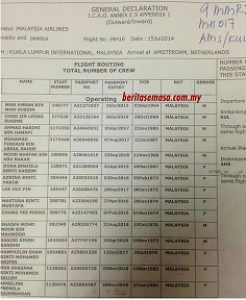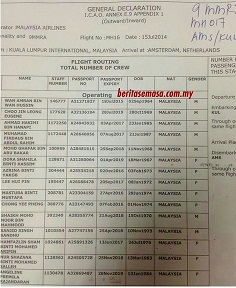The MH017 Pilots held the secret. Prevention is better than the Cure.
Theories about what happened and who shot the aircraft down will fill the networks for a long time.
But the answer to this tragedy was staring at us well before the plane left the ground.
The clues are not in the wreckage; the Captain and Crew were the keepers of the secret.

Air accidents will continue yet the ability to lessen the loss of life is unfolding. Research has the answers.
When a common denominator is recognised as being present at the fore of accidents, and using the available records of pilots who flew the ill-fated aircraft, one has to ask the question...
"What is it and how do we find it before a pilot can be given the 'all clear' for take-off?"
Random spot checks for alcohol and drug use are scheduled to keep pilots on their toes when rostered for flights, especially with passenger aircraft.
The importance of this is obvious, but what if a pilot was really sick and felt they were not fit to fly? This is when they phone in and say "I'm sick and I don't feel confident I can pilot the flight today. Can you roster in a standby please". That's all it takes for increased aircraft safety.
The drug, alcohol and 'wellness' checks may well be in place to improve safety of the passengers, crew and aircraft as Standard Operating Procedures (SOP), but...
But what if the pilot has an unseen heart condition or is a potential contender for a stroke or some other debilitating condition that could put the entire aircraft at serious risk, what then?
This is what standby flight officer/s are for (second officer), to take over the flight if things go awry. It is backup SOP.
BUT AGAIN
What if some serious and undetected mechanical condition arises in the aircraft, another plane is in the same flight path and a mid air collision is imminent, or a terrorist or highjacker has found their way on board, or a missile is to be launched at the plane; how do drug, alcohol and wellness checks stand up to these scenarios?
BACK TO MH017
There are conditions in every person that cannot be detected by conventional means that affect an individual when they are in periods susceptible to weaken their otherwise healthy state of being. Things such as;
Experiencing anxiety,
A relationship or personal loss,
An undetected heart condition,
Are simply in a bad mood and mentally preoccupied,
Having a financial or stress crisis,
Or a missile is about to impact; what then?
Research has shown these conditions are able to be detected well before any pilot enters the aircraft cockpit.
The means to assess these conditions is little different to the complexities of the chemical process for drug and alcohol testing, the technological ability for DNA matching in crime, the use of a brain scan to see a malformation such as cancer without first having to perform exploratory surgery.
We have come a long way and the average person does not have the faintest idea of how these 'magic' machines can do the work they do, but people accept it as the norm today.
The means to assess if a pilot is in a condition where they are in personal danger and may therefore be placing others in danger is presently proving to be a very real method of analysis no different to the means to see what has been invisible to man before.
The Pilots and flight crew have been assessed and the results indicate:
CAPTAINS and First Officers:
Capt Eugene Leong - potential life threatening period
Capt Wan Hussin - personal ending time
Vice Capt Ahmad Hanapi - serious danger
Vice Capt Muhamad Rahim - emotional and material endings
CREW:
Angeline Rajandaran - major change in life direction
Azina Yakob - a bad day to be flying
Chong Pheng - a bad day to be flying
Dora Kassim - personal and material endings
Hamfazlin Arifin - in extremely dangerous circumstances
Lee Pin - bad year, bad day
Mastura Mastafa - bad day and felt something was wrong
Mohd Bakar - having bad feelings about things
Nur Salleh - life changing year, very bad day to fly
Sanjid Sandhu - worried sick over something?
Shaikh Mahmood - life changing year, very bad day to fly.
On Saturday, 26th July at the "Fly A Jet" flight simulator premises, 17 Halsey Street - downtown Auckland, the secret of how to identify the pre flight condition of the Crew will be given to you.
This premier show may be the turning point in Air Safety and not to be missed whether you are a frequent or infrequent flyer.
A video screen with show you the evidence the world is looking for. Be among the first to see this. The seminar is free, the venue and food requires a small fee ($10) to cover costs.


